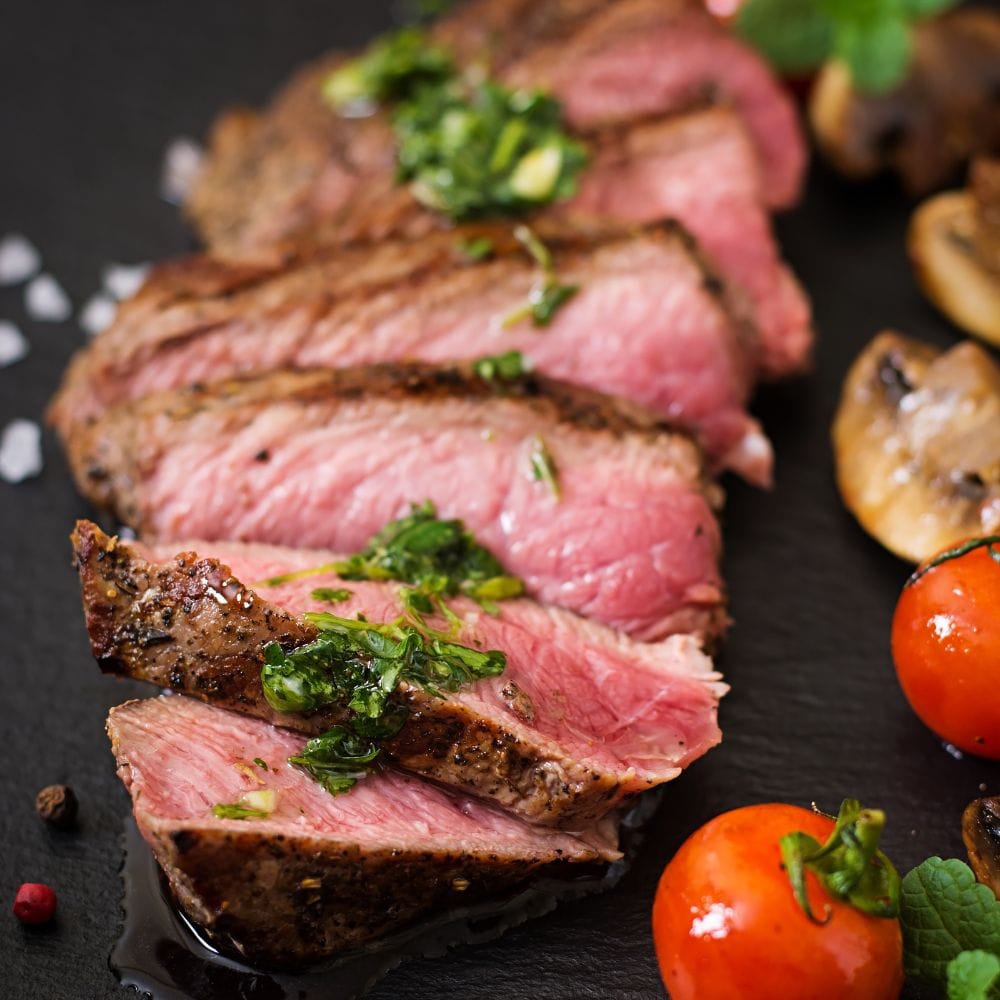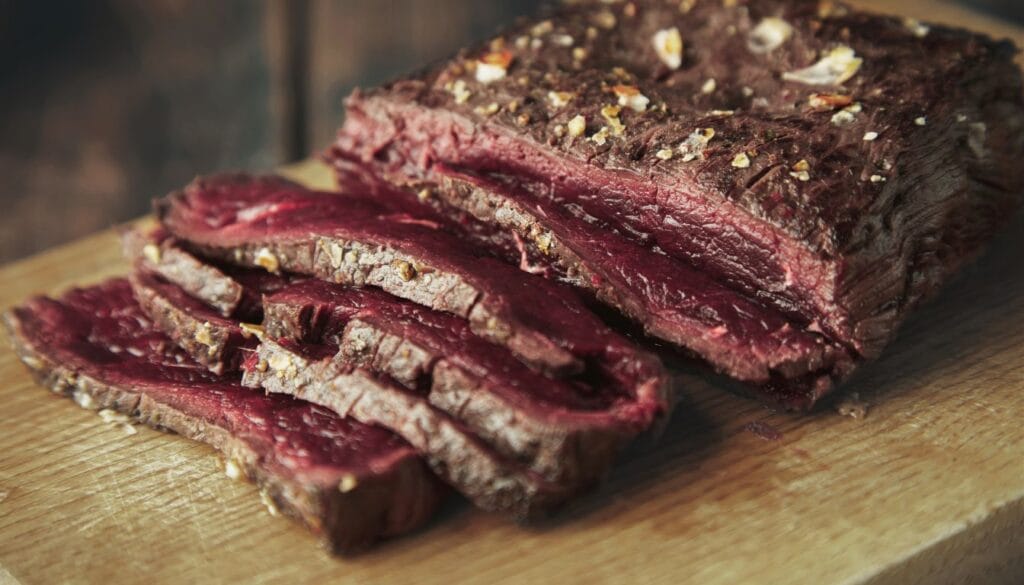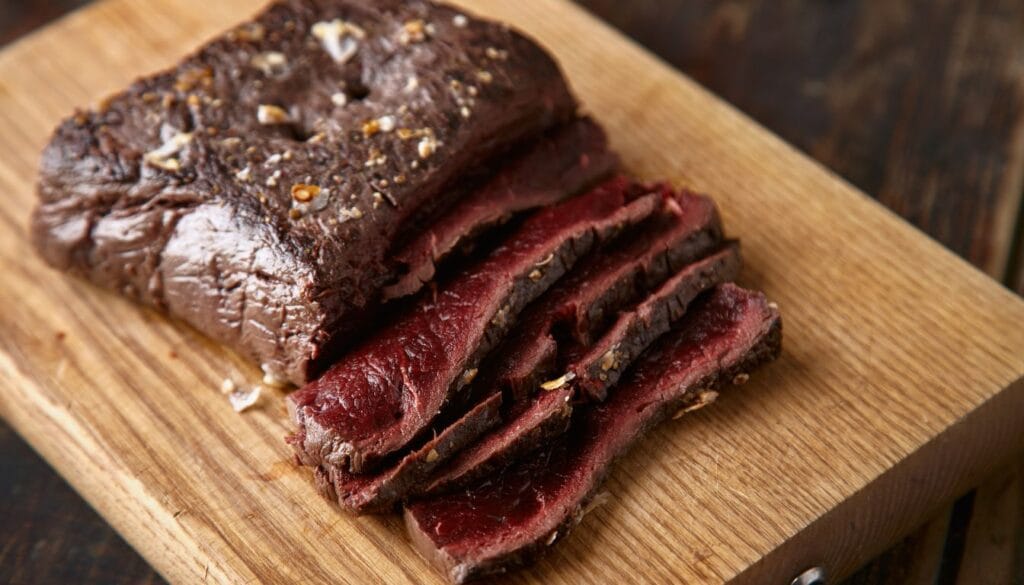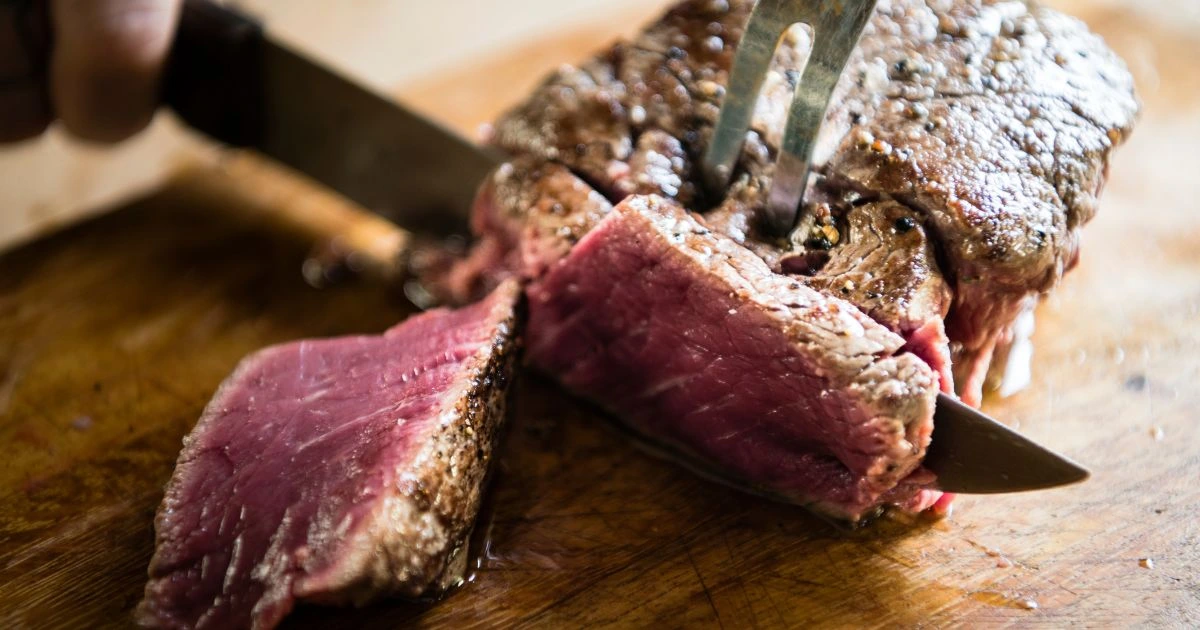Every culinary adventure starts with a bold move. For steak fans, this ultra-rare steak is the top thrill. It’s a raw, bold experience that pushes the limits of cooking and excites adventurous eaters.
Blue steak is more than a meal; it’s a bold statement. It turns beef into a work of art, highlighting its pure taste and soft texture. Picture cutting into a steak so rare that its inside is a cool blue. It shows off the chef’s skill and daring.
For chefs and steak lovers, blue steak is more than a cooking method. It’s a celebration of top-notch beef. Each slice tells a story of great meat, expert cooking, and respect for its natural qualities.
In fancy steakhouses in New York to unique spots in San Francisco, this dish wins over diners. It’s for both seasoned foodies and curious newcomers. This journey promises to change how you see perfectly cooked beef.
Table of Contents

Blue Steak
Ingredients
Equipment
Method
- Prepare the Meat: Remove steak from the refrigerator and let it sit at room temperature for 30–45 minutes.
- Pat Dry: Use paper towels to dry the surface thoroughly — this helps achieve a perfect sear.
- Season: Sprinkle sea salt and cracked black pepper evenly over both sides.
- Preheat Pan: Heat a cast-iron skillet until it’s extremely hot (450–500°F). Add a touch of oil if desired.
- Sear: Place the steak in the pan and sear for 30–90 seconds per side — just enough to brown the surface while keeping the interior nearly raw.
- Check Temperature: The internal temperature should reach 115–120°F (46–49°C).
- Rest: Transfer the steak to a plate and let it rest for 3–5 minutes to redistribute juices.
- Serve: Slice and serve immediately, optionally with herbs or a pat of butter on top.
Notes
- Safety First: Only use fresh, high-quality whole muscle cuts from trusted sources.
- Avoid Ground or Pre-Cut Beef: These are unsafe for blue steak.
- Ideal Cuts: Tenderloin, ribeye, or strip steak, all tender and well-marbled.
- Pittsburgh Style Option: Cook longer on extreme heat to char the outside (“black and blue”).
- For Beginners: Practice temperature control using a meat thermometer.
- Resting Time Is Crucial: It enhances tenderness and flavor.
What Makes this dish Unique
Blue steak is a culinary adventure that breaks the mold of traditional cooking. It’s a standout in meat preparation, offering a unique taste experience. This fascinates chefs and food lovers alike.
The art of steak doneness involves a special cooking technique. Chefs sear the outside while keeping the inside rare. This creates a stunning presentation.
The Origin of the Blue Color
The term “blue” doesn’t mean the meat is blue. It refers to the minimal cooking that keeps the center almost raw. This results in a striking contrast:
- Extremely hot exterior with deep brown sear
- Cool, red interior with minimal heat penetration
- Internal temperature around 120°F
Temperature and Cooking Standards
Perfect blue steak doneness needs precise temperature control. Chefs use high heat for a quick sear. This seals in flavors while keeping the inside raw.
Texture and Flavor Profile
Blue steak offers a unique sensory experience. The outside is crisp and caramelized, while the inside is tender and almost raw. This method keeps juices in and intensifies the beef flavor, appealing to the bold.
“Blue steak is not for the faint-hearted, but for those who appreciate meat in its most primal form.” – Culinary Expert
The Modern History of Rare Steak Preparation

The journey of making blue steak shows a big change in American food tastes. Before, people cooked meat a lot to make it safe. They thought rare meat was risky and unhealthy.
By the mid-20th century, cooking steak changed a lot. Europeans taught Americans new ways to cook. New tools and knowledge helped a lot:
- Precision meat thermometers helped control temperature
- Better refrigeration made meat safer to store
- More cooking classes taught about meat
Restaurants in big cities like New York and San Francisco led the change. Chefs started making blue steak, offering diners rarer options. The Pittsburgh style became famous for its quick, hot sear and raw inside.
Rare steak was no longer seen as dangerous but as a special treat needing skill.
By the 1980s and 1990s, blue steak became popular everywhere. People loved its strong taste and softness from little cooking.
Understanding Blue Steak Safety and Quality
Preparing this dish needs careful attention to safety and quality. Many people want to know the best way to cook blue steak. But, it’s also important to know how to handle and prepare the meat safely.

The safety of steak depends on several key factors. Choosing high-quality meat is the first step to a safe and tasty meal. It’s important to pick fresh, top-grade steak cuts from trusted sources.
Proper Temperature Control
Temperature control is key when cooking blue steak. The outside must get hot enough to kill surface bacteria. But, the inside should stay raw.
- Sear the exterior at high heat (around 450-500°F)
- Cook time should be extremely brief (30-45 seconds per side)
- Use a meat thermometer to verify surface temperature
Selecting Premium Cuts
Not all cuts are the same for blue steak. Choosing premium cuts is important for both flavor and safety.
| Cut Quality | Safety Rating | Recommended Usage |
| Prime Beef | Excellent | Ideal for blue steak |
| Choice Beef | Good | Acceptable with careful preparation |
| Select Beef | Caution Advised | Not recommended for blue steak |
Food Safety Considerations
It’s important to know the risks. Fresh, whole muscle cuts are safest for blue steak. Bacteria mainly live on the surface, which searing can kill.
Always source meat from trusted butchers and maintain strict hygiene during preparation.
Professional chefs say to buy meat from reliable sources. Handle it carefully to avoid health risks from eating blue steak.
Essential Techniques for Perfect Blue Steak

Mastering the blue steak recipe needs precision and careful technique. the steak is cooked the least, leaving the inside almost raw. It gets a quick sear on the outside.
To make it well, chefs must pay attention to a few key things:
- Choose a high-quality beef cut with great marbling
- Make sure the meat is at room temperature before cooking
- Use an extremely hot cooking surface
- Sear for about 60-90 seconds on each side
The best blue steak recipe needs extreme heat and short cooking time. Experts suggest using a cast-iron skillet or heavy-based pan. This helps get a perfect crust on the outside and keeps the inside almost raw.
Here are the main steps for a real blue steak:
- Pat the steak dry with paper towels
- Season well with kosher salt and black pepper
- Heat your cooking surface until it’s very hot
- Cook for less than two minutes total
- Let the steak rest for 3-4 minutes before serving
Pro tip: The thickness of your steak affects cooking time. Adjust as needed and use a meat thermometer for accuracy.
Seasoning and Preparation
Making the perfect blue steak is all about balance. It’s not just about adding salt and pepper. It’s about bringing out the meat’s natural taste while keeping its unique qualities.

Professional chefs take great care in preparing this meal. They aim to create a memorable dish that showcases the meat’s true flavors.
Pre-Cooking Requirements
Before cooking, there are key steps to follow. These steps ensure the steak turns out right.
- Bring the steak to room temperature (approximately 30-45 minutes before cooking)
- Pat the meat dry with paper towels to ensure proper searing
- Select high-quality cuts with good marbling
Expert Seasoning Methods
Seasoning blue steak is all about keeping it simple and using quality ingredients. The best way is to:
- Use coarse sea salt
- Apply freshly cracked black pepper
- Keep seasoning to a minimum to preserve the meat’s natural taste
| Seasoning Type | Recommended Amount | Best Used With |
| Sea Salt | Light coating | Premium beef cuts |
| Cracked Pepper | Moderate sprinkle | Ribeye and tenderloin |
| Herb Blend | Minimal | Special occasion steaks |
Resting Guidelines
Resting the steak is very important. Let it rest for 3-5 minutes after cooking. This helps the juices spread evenly, making the steak more flavorful and tender.
“The secret to a perfect blue steak is respecting the meat’s natural qualities and using minimal intervention,” says Chef Michael Rodriguez, renowned meat preparation expert.
Pittsburgh Style: The Black and Blue Method

The Pittsburgh style steak, also known as the “black and blue” method, is a special way to cook a steak. It started in Pittsburgh’s steel mills. Workers cooked their steaks on hot metal plates, making the outside charred and the inside almost raw.
Key characteristics of the Pittsburgh style steak include:
- Extreme high-heat searing
- Extremely short cooking time
- Blackened exterior
- Completely blue (raw) interior
To make the perfect Pittsburgh style steak, chefs use a cast-iron skillet or a high-heat grill. They aim for a crispy crust and an inside that’s below 115°F.
| Cooking Method | Exterior Texture | Interior Temperature |
| Pittsburgh Style | Charred and crispy | Below 115°F (Blue) |
| Traditional Grilling | Lightly browned | Varies by preference |
Professional chefs say to choose high-quality cuts like ribeye or New York strip for the best Pittsburgh style steak. The intense heat gives a smoky char and a rich beef flavor.
Best Cuts for Blue Steak Excellence
Choosing the right cut of meat is key for a great blue steak. The best cuts are premium beef that stays tender and flavorful even when cooked briefly.
Some cuts are better than others for this recipe. Knowing which cuts to choose can make your steak experience unforgettable.
Premium Cut Selection Guide
- Tenderloin: The top choice for blue steak
- Extremely tender
- Minimal muscle fiber
- Soft, buttery texture
- Flat Iron Steak
- Sourced from chuck area
- Exceptional tenderness
- Robust flavor profile
- Ribeye
- Rich marbling
- Intense beef flavor
- Excellent for blue steak preparation
Meat Quality Indicators
Professional chefs say to look for these when picking beef for blue steak:
- Consistent marbling
- Bright red color
- Firm texture
- USDA grading (Prime or Choice)
High-quality meat makes your blue steak dinner unforgettable. It’s all about the taste and quality.
Professional Tips for Restaurant-Quality Results
Mastering blue steak is all about precision and using professional techniques. These methods take your home cooking to the next level. Professional chefs know that making the perfect blue steak is more than just fast cooking. It’s an art that needs skill and knowledge.
Here are some expert tips for making blue steak:
- Use a cast-iron skillet for optimal heat distribution
- Select high-quality, thick-cut beef with excellent marbling
- Bring meat to room temperature before cooking
- Pat meat completely dry to ensure perfect searing
The secret to making this meal like a pro is knowing how to manage heat and timing. Chefs suggest using a meat thermometer. This helps get the perfect internal temperature of 115-120°F.
| Technique | Professional Recommendation |
| Seasoning | Minimal kosher salt and fresh cracked pepper |
| Cooking Surface | Extremely hot cast-iron skillet |
| Cooking Time | 45-60 seconds per side |
Pro tip: Let the steak rest for 3-5 minutes after cooking. This helps the juices spread and keeps the flavor intense.
“The key to exceptional blue steak is respecting the meat’s natural qualities,” says renowned chef Michael Ruhlman.
Conclusion
Blue steak is a journey for those who love beef. It brings out the best in high-quality meat, offering a bold flavor and unique texture. To make rare blue steak, you need skill, precision, and knowledge of meat.
Trying blue steak means respecting both cooking art and food safety. It’s important to choose the best cuts and know how to cook them right. This way, you can make a memorable meal for yourself or others.
Blue steak is more than just cooking. It’s about understanding how meat quality, cooking, and taste work together. For those ready to try something new, blue steak is a special way to enjoy top-notch beef.
Whether you’re a pro chef or a home cook, diving into this recipe can be exciting. With time and the right approach, you can learn to make amazing beef dishes. It’s all about enjoying the process and the end result.
FAQ
What exactly is blue steak?
Blue steak is a rare beef dish. It’s cooked quickly at high heat. This makes the outside charred and the inside almost raw.
The steak is seared briefly to get a deep red or bluish-red center. This is due to an internal temperature of 115-120°F.
Is it safe to eat?
Safety is a big concern with blue steak. It’s not fully cooked, which can be risky.Make sure to use fresh, high-quality meat. Searing the outside helps kill bacteria. But, people with weak immune systems should avoid it.
How is blue steak different from rare steak?
Blue steak is less cooked than rare steak. It’s seared for a very short time. This keeps the inside at 115°F.Rare steak, on the other hand, is cooked a bit more. It reaches 125°F, with a slightly firmer interior.
What are the best cuts for blue steak?
The best cuts are tenderloin, ribeye, and strip steak. These are tender and have good marbling. They handle the quick cooking well.
What is Pittsburgh-style or “black and blue” steak?
Pittsburgh-style steak is cooked at extremely high heat. It gets a charred outside and a raw inside.It’s inspired by steel workers who cooked steaks on hot metal. This method creates a unique flavor and texture.
How do I prepare blue steak at home?
Use a cast-iron skillet or a very hot grill. Let the meat warm up to room temperature. Season it lightly, then sear for 30-45 seconds on each side. Use a thermometer to check the temperature. Let it rest before serving.
What seasoning works best for this dish?
Keep steak seasoning simple. Use coarse sea salt and black pepper just before cooking. This lets the meat’s flavor shine. Some chefs might add a light oil like grapeseed or avocado oil.
What are the key food safety considerations for blue steak?
Safety is key. Use fresh, high-quality meat. Searing the outside kills bacteria.Avoid cross-contamination and use clean utensils. Be cautious for vulnerable groups like children and the elderly.
What temperature defines blue steak?
Blue steak is cooked to 115-120°F. This is much lower than medium-rare. The quick cooking and high heat are what make it blue steak.
Can I order blue steak at most restaurants?
Blue steak is not common in most restaurants. High-end steakhouses might offer it, but it’s not universal. Always check with the chef or staff.
There are no reviews yet. Be the first one to write one.

